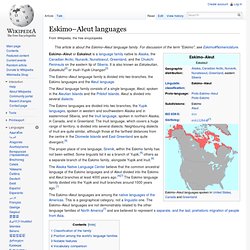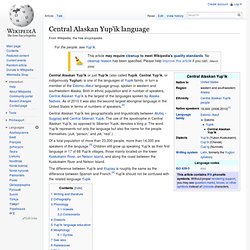

Eskimo-Aleut languages. Eskimo–Aleut or Eskaleut is a language family native to Alaska, the Canadian Arctic, Nunavik, Nunatsiavut, Greenland, and the Chukchi Peninsula on the eastern tip of Siberia.

It is also known as Eskaleutian, Eskaleutic[2] or Inuit–Yupik-Unangan[3] The Eskimo–Aleut language family is divided into two branches, the Eskimo languages and the Aleut language. The Aleut language family consists of a single language, Aleut, spoken in the Aleutian Islands and the Pribilof Islands. Aleut is divided into several dialects. The Eskimo languages are divided into two branches, the Yupik languages, spoken in western and southwestern Alaska and in easternmost Siberia, and the Inuit language, spoken in northern Alaska, in Canada, and in Greenland. The proper place of one language, Sirenik, within the Eskimo family has not been settled. Central Alaskan Yup'ik language - Wikipedia, the free encycloped. Central Alaskan Yup'ik or just Yup'ik (also called Yupik, Central Yup'ik, or indigenously Yugtun) is one of the languages of Yupik family, in turn a member of the Eskimo–Aleut language group, spoken in western and southwestern Alaska.

Both in ethnic population and in number of speakers, Central Alaskan Yup'ik is the largest of the languages spoken by Alaska Natives. As of 2010 it was also the second largest aboriginal language in the United States in terms of numbers of speakers.[2] Central Alaskan Yup'ik lies geographically and linguistically between Alutiiq ~ Sugpiaq and Central Siberian Yupik. The use of the apostrophe in Central Alaskan Yup'ik, as opposed to Siberian Yupik, denotes a long p.
The word Yup'ik represents not only the language but also the name for the people themselves (yuk, 'person,' and pik, 'real'.) Writing and literature[edit] Orthography[edit] The three main vowels a i u, also occur long, aa ii uu. Phonology[edit] Vowels[edit] Consonants[edit] Dialects[edit] Syntax[edit] Inuit language. The Inuit languages are a closely related group of Native American languages traditionally spoken across the North American Arctic and to some extent in the subarctic in Labrador.

The related Yupik languages are spoken in western and southern Alaska and Russian Far East, particularly the Diomede Islands, but are severely endangered in Russia today and spoken only in a few villages on the Chukchi Peninsula. The Inuit live primarily in three countries: Greenland (a constituent of the Kingdom of Denmark), Canada (specifically the Nunatsiavut region of Labrador, the Nunavik region of Quebec, Nunavut, and the Northwest Territories), and the United States (specifically the state of Alaska). The total population of Inuit speaking their traditional languages is difficult to assess with precision, since most counts rely on self-reported census data that may not accurately reflect usage or competence.
The Inuit languages have a few hundred speakers in Russia. Nomenclature[edit] Athabaskan languages. Athabaskan or Athabascan (also Dene, Athapascan, Athapaskan) is a large family of indigenous languages of North America, located in two main Southern and Northern groups in western North America. In terms of territory, only the Algic languages cover a larger area. Most Athabaskans prefer to be identified by their specific language and location. Although the general term Athabascan persists in linguistics and anthropology, in 2012 the annual Athabaskan Languages Conference changed its name to the Dene Languages Conference. Etymology[edit] The word Athabaskan is an anglicized version of a Cree language name for Lake Athabasca (Cree: Aδapaska˙w “[where] there are reeds one after another”) in Canada.[2] The name was assigned by Albert Gallatin in his 1836 (written 1826) classification of the languages of North America.
I have designated them by the arbitrary denomination of Athabascas, which derived from the original name of the lake.—1836:116-7 Languages[edit] Overview[edit] 1. 2. 3. 4. 5. 6.